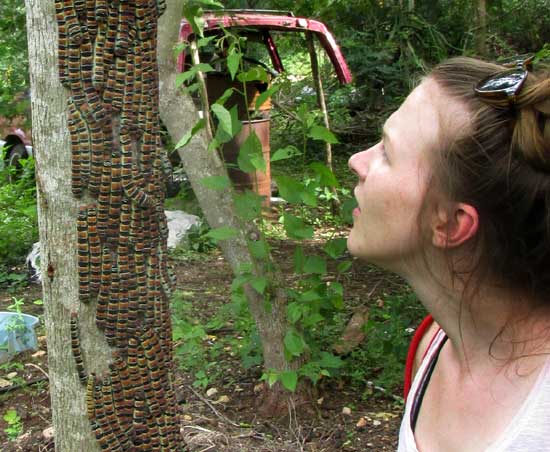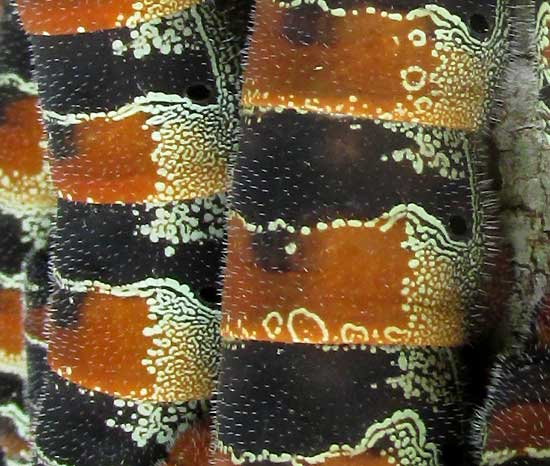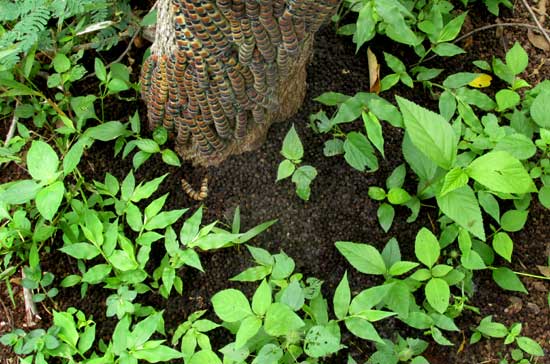Excerpts from Jim Conrad's
NATURALIST Newsletter
from the August 6, 2017 Newsletter issued from Rancho Regenesis in the woods ±4kms west of Ek Balam Ruins; elevation ~40m (~130 ft), N20.876°, W88.170°; north-central Yucatán, MÉXICO
ARSENURA ARMIDA CLUSTERING CATERPILLARS
I was showing some German guests around the rancho when we came upon something amazing. Below, you can see one of the guests standing next to the discovery:

Notice the dark smudge on the tree trunk's side, extending from the ground to the top of the picture. A closer-up view of the smudge is shown below:

They're caterpillars. We've documented large caterpillars clustering on tree trunks before, at Chichén Itzá. You can see that those were somewhat different, though, at www.backyardnature.net/yucatan/papilio.htm
Our present caterpillars are much more colorful. Below, just look at a close-up of their mid-sections, a psychedelic picture worth framing:

Another view, of a head from above, is shown below:

The clustering caterpillars previously seen at Chichén Itzá were larvae of swallowtail butterflies, so I assumed that these also where swallowtail larvae. However, searching for images of such caterpillars among the swallowtails turned up nothing. Then I tried adding to the keywords the name of the tree on which our rancho caterpillars were feeding, which was Guazuma ulmifolia, a member of the Hibiscus Family, the Malvaceae. This information turned up good matches.
Our rancho's gaudy, clustering caterpillars are larvae of the Giant Silk Moth ARSENURA ARMIDA, distributed from Mexico to Ecuador and Brazil in South America. During the day the larvae rest on tree trunks, where they depend on their warning coloration, or "aposematim," to keep predators away from them. They feed at night, then return to their resting spot at dawn by following scent, or pheromone, trails. After the larva's 4th instar, or growth stage, it descends to the ground, digs a hole , crawls into it, and pupates. The adult that emerges from the pupa is a large, brown moth with a wingspan of 10-12cm (4inches).
One feature of the caterpillar's feeding behavior is especially interesting and hard-to-explain: During early instars the caterpillars cluster in separate patches and forage nomadically. As they age, however, they shift to a central foraging location. A more detailed discussion of this behavior and the theories about it is provided on the species' Wikipedia page.
Our caterpillars are older, late instar ones and their central foraging and resting location is the Guazuma ulmifolia whose trunk is shown in the picture. An idea of how much the caterpillars feed is provided by the mound of caterpillar poop at the tree's base, shown below:

Guazuma ulmifolia, a member of the Hibiscus Family, is one of the most common trees in our area, and I'd guess that the one in the picture has had about one-fifth of its leaves stripped by the caterpillars. Below, you can see a typically caterpillar-munched-on branch:

Though large, late instars of the caterpillar are so toxic that they've been known to kill trogon nestlings when fed to them, the smaller, early instars traditionally have been eaten by people in some places, such as in Mexico's Veracruz state, where they are cooked. The larvae also have been preserved in vinegar, which is reported to impart to them the taste of herring.